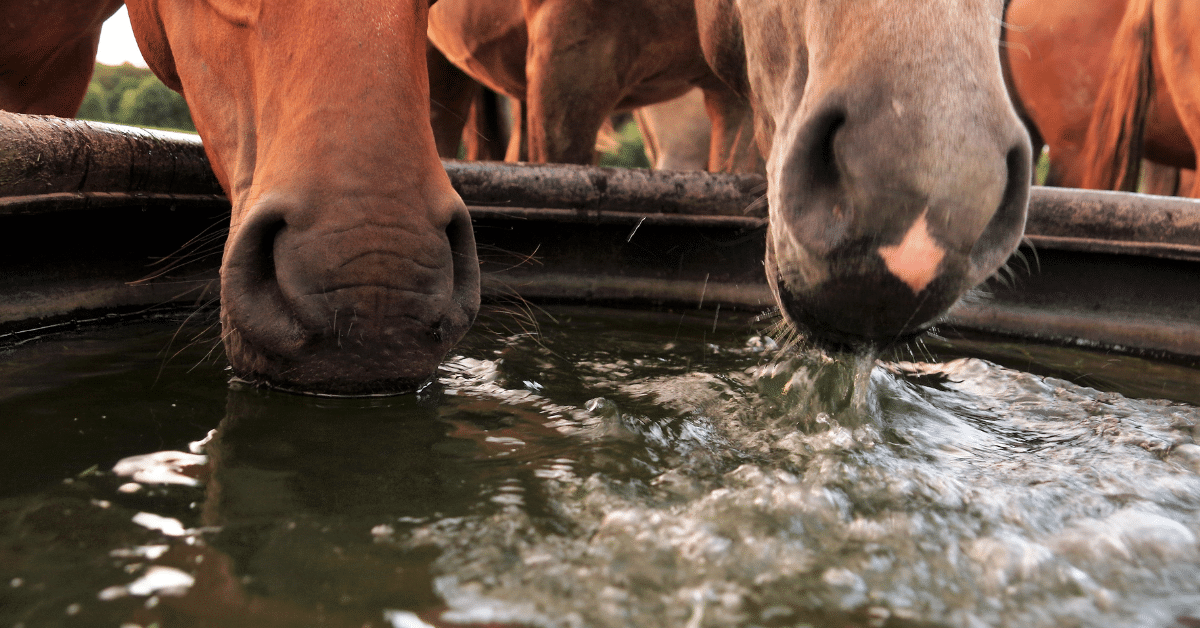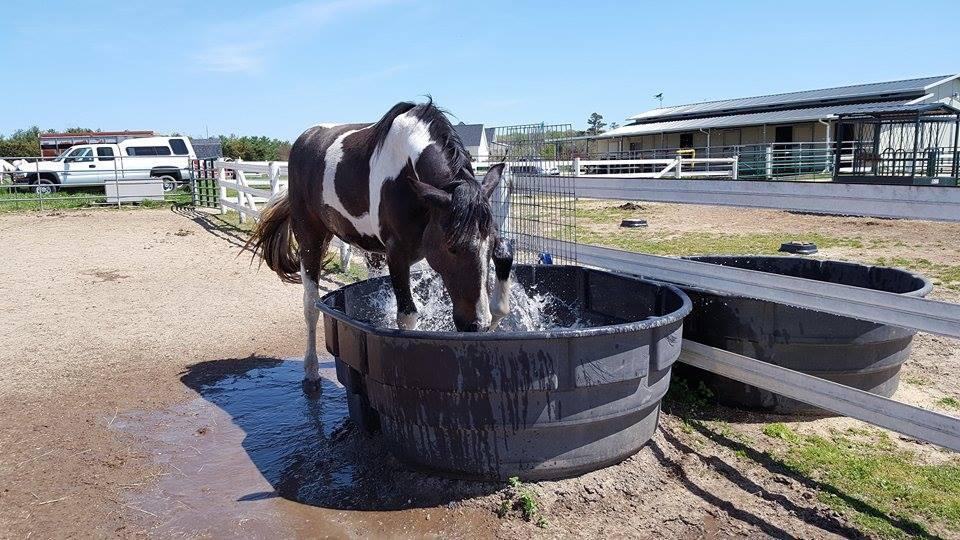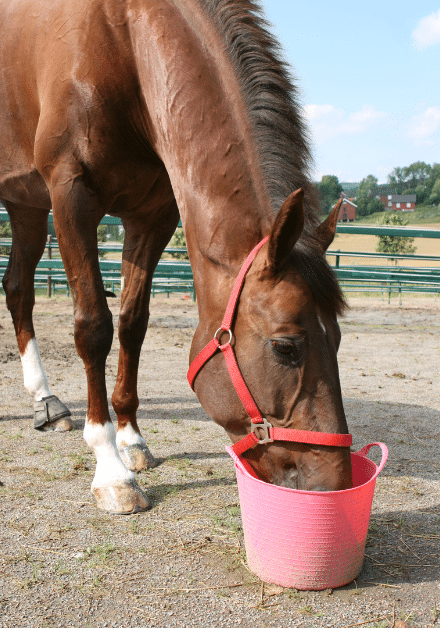Horse Water Trough: Everything You Need to Know
Affiliate Disclaimer: This article contains Amazon affiliate links. Double D Trailers receives a commission with purchased products. Our reviews and suggestions are always 100% factual and unbiased.

Some of us have natural water sources on our property that our horses will be able to access. While allowing your horse to drink from a natural water source is an option, it may not be the best one.
A horse water trough will guarantee that you are providing your horse with water that is clean and fresh, and it allows you to monitor how much water your horse is consuming.
Why Horse Troughs are Necessary
The most practical way to keep your horse hydrated with quality water and monitor their intake is by providing their water in a horse trough.
Horse Water Troughs Provide Good Quality Water
If you’ve ever seen a horse drink, you may know that this animal doesn’t have the most manners. When horses drink, they tend to carry their leftover hay, grass, or any other debris right into their drinking water. When you’re investing in a horse trough, it’s important to look for one that has some type of drain to easily eliminate any debris that may accumulate in the water.
Horse Troughs Let You Monitor Water Intake
If your horse completely refuses to drink, or greatly cuts back on their water intake, it can cause a wide array of issues. Just a few of the outcomes of dehydration in horses include poor performance, digestive issues, colic, and organ failure in extreme cases.
Unfortunately, many horse owners miss the preliminary signs of dehydration. Providing a water trough for horses is a great way to combat this and keep track of how much water that your horse is drinking on a daily basis. This way, you’ll know if they suddenly stop drinking their normal amount and can speak with your vet immediately.
How Much Water Does a Horse Need?
As mentioned earlier, water is one of the key nutrients that horses need to function properly. The other nutrients include fats, carbohydrates, protein, vitamins, and minerals. According to research, water is by far the most important nutrient. Without water, all of the other nutrient levels can easily become off-balance in their bodies.
When Does My Horse Need the Most Water?
The American Association of Equine Practitioners recommends an idle 1,100 lb. horse drink anywhere from 6-10 gallons of water on a daily basis. However, there are other factors that come into play that may affect just how much water your horse is drinking.
Temperature
The temperature of the water will greatly affect how much water that your horse consumes. On average, horse water consumption has shown to be optimal when the water temperature is between 45-65 degrees Fahrenheit.
In addition, the outside temperature will also play a role in how much water your horse will drink. Horses typically drink more water in hot and humid weather, whereas colder weather generally decreases how much water that they will consume.
Exercise
How much exercise that your horse gets on a daily basis can cause water intake to fluctuate as much as 20+ gallons. The same idle 1,100 lb. horse that needs around 6-10 gallons of water on the average day, can increase to closer to 30 gallons/day on a high exercise day.
Diet
Depending on the time of year and what your horse’s diet consists of will also determine how much water that they need to drink. For example, during the summer, if your horse is free to roam in your pasture, they may be consuming less water. This is because they’re getting a lot of moisture from the grass that they’re grazing on.
In contrast, if they are stalled during the winter and are fed a hay or grain-based diet, they will drink more water (although they are actually probably consuming around the same amount in both the summer and the winter – they just get most of their water intake from the grass in the pasture during the summer).
Other factors that can change how much water that a horse will drink include:
-
Physical condition of the horse
-
Age
-
Salt intake
-
Pregnancy/Nursing
How Big of a Water Trough Does a Horse Need?
There is no “one-size fits all” answer for the right size water trough needed for your horse(s). The gallon size will largely depend on how many horses that you have and how many are drinking from that trough. For a large pasture with several horses, you’ll need to get a larger trough, in the 100–150-gallon range. If you’re only watering 1 or 2 horses, you can get away with a smaller trough size.
How Much Does a Horse Water Trough Cost?
Horse water troughs have a wide variety of price ranges. The price largely depends on the material of the horse trough that you choose, as well as how many gallons it will hold. You can purchase a very basic horse trough for less than $100.
What is the Best Material for a Horse Trough?
There are a few different materials that make up the majority of horse water troughs. Of course, there are pros and cons to whatever type of horse trough that you buy. Deciding which material type is the best for you is the first step in purchasing one that will best suit the needs of your horse.
Metal Horse Water Troughs
You may have heard of horse troughs constructed of metal referred to as “galvanized” troughs. These horse troughs are made of metal, but they are galvanized with zinc through a dipping process. The galvanized zinc coating will help in rust prevention.
Advantages
-
Sturdy and durable
-
Less likely to break as a result of impact
-
Typically available in bigger sizes than other materials
A member of our online Facebook community, the Horse Trailer Forum, shared that she has used the galvanized metal for years. Judi shared that she prefers them over plastic because she has a horse that likes to play in them, and her horse has broken the plastic troughs before.
Pictured: Judi’s horse playing in her plastic horse trough
Disadvantages
-
Can rust or corrode if not properly cleaned/maintained
-
Harder to install
-
More expensive
-
Does not melt frozen water quickly in the winter time
Another reported disadvantage of metal horse troughs from a member of our Facebook community group, “Have used and had to clean galvanized 150-gallon metal troughs. They get dented by horses accidently bumping them. Scrubbing is hard on the bottom with a brush. Sure, they keep the water a bit cooler but they get algae just as easy as the black rubber ones.”
Plastic Horse Water Troughs
Plastic horse troughs are also sometimes called poly water troughs. This material is the most commonly used in water trough production.
Advantages
-
Lightweight
-
Easy to move
-
Easy to install
-
No rust or corrosion
-
Can be self-cleaning
-
Less conductive of heat
-
More budget-friendly
Disadvantages
-
Flimsier than metal
-
Not always available in big gallon sizes
-
Can crack (especially in the winter time)
-
Some additional framework may be needed at installation to hold up the frame when filled
Rubber Horse Water Troughs
On average, a rubber horse water trough will be the most expensive material out of the three. We consider rubber a “happy mix” of the advantages and disadvantages of both metal and plastic.
Advantages
-
No rusting or corrosion
-
Won’t crack
-
Not as heavy as metal, but sturdier than plastic
-
Not a good conductor of a heat
-
Sturdy
Disadvantages
-
Can get pricey
-
Can be more difficult to install
Can You Use a Trash Can as a Water Trough for Horses?
In short, the answer is yes. If you’re in a pinch and have some spare trash cans laying around, these can be used as water troughs for your horses. Of course, trash cans will require more frequent cleaning than a water trough. In fact, some members from our online community shared that they prefer to use trash cans.
“We use 32-gallon trash cans. Tend to get less stuff in them than a lower height muck tub or trough. We also prefer a smaller gallon capacity as we empty/scrub often, and it also makes it easier to monitor consumption. Each horse gets their own and they are topped off daily.” – Aidan
 Can’t I Just Put the Water in Buckets?
Can’t I Just Put the Water in Buckets?
If your horse is frequently stalled and doesn’t have a lot of pasture time other than for turnout or play time, a stall bucket can be a good option. Buckets might be the right fit for you if you’re headed to their stall multiple times a day. This is so you can frequently refill the buckets and clean them. Similarly to using trash cans, buckets will need to be dumped and cleaned on a more frequent basis.
Victoria, one of our e-mail newsletter subscribers shared with us that, “We just use buckets for our horses/show horse since [they are] in stalls (don't live outside other than to play and train). We use two water buckets which hang inside the stalls and get manually filled throughout each day.”
In addition, we heard from Chris in Florida. Chris shared, “I only have one horse and a pony, who are separated. I am in central Florida and water gets hot and gross. I only use a muck bucket, kept under his shelter, for the big horse. I dump it almost every day. The pony has a 5-gallon bucket and I do the same with her.”
Are Automatic Waterers Better than Water Troughs?
Deciding if you should install water troughs on your property or invest in an automatic waterer is a matter of preference. Our team here at Double D Trailers tends to lean toward the side of preferring water troughs. The main reason being is that it’s one less thing that can malfunction. If you’re a horse owner, you know that the less things you have that can break down on you, the better.
Where to Install a Horse Water Trough
A horse trough can be installed in many different places. To answer this question, let’s look at the 3 most common placements for water troughs.
Where to Install a Horse Trough in a Pasture
Ideally, water troughs should be placed along the fence line. Be sure to install the trough near a water source so that it will be easy to fill and clean.
Tip: If you have multiple horses in your pasture at the same time, it’s a good idea to place water troughs in several places throughout the pasture. Some horses are aggressive while eating and drinking, so this just prevents any fighting or injuries occurring at the troughs.
Where to Install a Horse Trough in Stall
There is no right or wrong placement for water troughs in your horse’s stall. The most important thing to remember is just to make sure that it’s easy for your horse to access, and it is also easy for you to refill and clean as needed.
Where to Install a Horse Trough in Horse Trailer
Although making sure that your horse is drinking enough water on a day-to-day basis is usually the primary concern of horse owners, making sure that they are well-hydrated while traveling in their horse trailer is also equally as important.
Typically, a water trough in the stall area of your horse trailer is not needed. In the past, we offered waterers built into our horse trailers. Shortly after, we stopped offering this feature on our horse trailers due to safety concerns.
Very quickly, we had reports of horses getting injured on the watering bowls while traveling, as well as water lines breaking. Instead, make sure that your horse trailer has a water tank. This way, when you’re traveling, you can easily and quickly fill up a bucket when stopped and let your horse rehydrate.
Here are a few tips to make sure that your horse stays safe and avoids becoming dehydrated while trailering:
-
Make sure your horse is hydrated before traveling. Providing an oral electrolyte supplement is a good idea for long trips, especially if it’s a really hot day.
-
Keep an eye on your horse. Check in on your horse trailer cameras and look for signs of heat stress. Some signs to look out for include flared nostrils and excessive amounts of sweat.
-
Avoid aluminum trailers. Aluminum is a great conductor of heat. This means that if your trailer has aluminum flooring or an aluminum roof, it will transfer excess heat to your horse.
Z-Frame Technology: Double D’s Solution to Rust and Corrosion While Protecting Your Horse
How to Keep a Horse Water Trough Clean
Step 1: Completely empty the trough and drain all of the old water.
Step 2: Scrub the trough clean with a hard-bristled brush. If the trough has thick debris build-up or algae, you can use a putty knife or toothbrush to help scrub away stubborn spots.
Step 3: Wash it with a bleach solution. To kill off any bacteria in the trough, you can use a bleach solution. Use 9 parts water to 1 part bleach to dilute the bleach.
Step 4: Rinse the trough thoroughly with just water.
Step 5: Refill the trough with clean water.
If you’re using a bucket in your stall, you can clean those by washing them out with dish liquid and scrubbing with a washcloth or some type of cleaning sponge.
Here is a quick video from TheHorse.com that gives a great walk-through on cleaning troughs and stall buckets.
How Often to Clean a Horse Trough
It’s recommended to clean your horse’s watering trough at least once a week. This includes removing all the debris and dirt and washing it with the bleach solution. In between weekly deep cleanings, you should keep a check on it to make sure that it’s free of big chunks of dirt or debris, and ensure there is no algae or mold growing.
However, the frequency of cleaning will largely depend on your horse. If your trough looks clean (i.e. there’s nothing growing in it and no critters swimming around) and your horse is drinking adequately, you may be able to get by with cleaning it on a monthly basis. Some horses are snobs about drinking clean and fresh water, while others don’t mind as much. Do what works for you and your horses.
Should You Put Fish in a Horse Water Trough?
Another method to keep the water in your horse’s trough clean is to add fish! Yes, you read that correctly. Specifically, goldfish. Goldfish can help to minimize algae and to get rid of mosquito larvae.
What is the Best Horse Water Trough to Buy?
In order to determine the best water trough out there for horses, we decided to go straight to the source. We sent out an email blast to our list of over 12,000 horse owners and lovers and asked what is their preferred trough.
We had many, many responses, and there was a common brand among the majority of those who shared their insights with us.
According to our readers, the best water troughs for horses are the Rubbermaid stock tanks. These horse water tanks come in a wide selection of sizes. They are fairly affordable, and they are available to purchase right on Amazon (you should also be able to find them at any local tack supply store near you or Tractor Supply).
Shop Rubbermaid Horse Stock Tanks on Amazon
Here are a few comments that we received for the Rubbermaid troughs from our readers:
“For every day tanks I love Rubbermaid. They are sturdy, handle cold temps well and are lighter and easier to maneuver than galvanized tanks.” – Sparky
“Rubbermaid! I can put a heater in for the winter.” – Margaret
“Rubbermaid. They don’t rust out, and the floats stay good.” – Jimmy
“We use Rubbermaid 100 gallon and 150-gallon water tanks in the main pastures. And Rubbermaid 300 gallon in the cattle pasture.” – Tom
Conclusion
Whether you’re using a trash can, buckets, an automatic watering system, or a horse water trough; what’s important is that you’re keeping your horses hydrated. The right method to water your horses will depend on what works for you and your horses.


 Can’t I Just Put the Water in Buckets?
Can’t I Just Put the Water in Buckets?